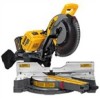Dewalt DHS790AT2 Instruction Manual - Page 20
MAINTENANCE, Removing and Replacing Belt Fig. 4, 35, Cleaning
 |
View all Dewalt DHS790AT2 manuals
Add to My Manuals
Save this manual to your list of manuals |
Page 20 highlights
English CUTTING LARGE MATERIAL (FIG. 32) Occasionally you will encounter a piece of wood a little too large to fit beneath the lower guard. If this occurs, simply place your right thumb on the upper side of the guard and roll the guard up just enough to clear the workpiece, as shown in Figure 32. Avoid doing this as much as possible, but if need be, the saw will operate properly and make the bigger cut. NEVER TIE, TAPE, OR OTHERWISE HOLD THE GUARD OPEN WHEN OPERATING THIS SAW. FIG. 32 SPECIAL SET-UP FOR WIDE CROSSCUTS (FIG. 33, 34) Your saw can cut very wide (up to 16.1" [409 mm]) workpieces when a special set-up is used. To set the saw up for these workpieces, follow these steps: 1. Remove both left and right sliding fences from the saw and set aside. To remove them, unscrew the fence adjustment knobs several turns and slide each fence outward. Adjust and lock the miter control so that it is at 0º miter. 2. Make a platform using a piece of 1.5" (38 mm) thick particleboard or similar flat strong 1.5" thick wood to the dimensions: 14.5" x 26" (368 x 660 mm). The platform must be flat, otherwise the material could move during cutting and cause injury. 3. Mount the 14.5" x 26" (368 x 660 mm) platform to the saw using four 3" (76.2 mm) long wood screws through the holes in the base fence (Fig. 33). Four screws must be used to properly secure the material. When the special set-up is used, the platform will be cut into two pieces. Ensure the screws are tightened properly, otherwise material could loosen and cause injury. Ensure the platform is firmly flat on the table, against the fence, and centered evenly from left to right. FIG. 33 FIG. 34 BASE FENCE CAUTION: Continued use of a platform with several kerfs may cause loss of material control and possible injury. MAINTENANCE WARNING: To reduce the risk of serious personal injury, turn tool off and remove the battery packs or power supply before transporting, making any adjustments, cleaning, repairing, or removing/installing attachments or accessories. An accidental start-up can cause injury. WARNING: To reduce the risk of serious personal injury, DO NOT touch the sharp points on the blade with fingers or hands while performing any maintenance. DO NOT use lubricants or cleaners (particularly spray or aerosol) in the vicinity of the plastic guard. The polycarbonate material used in the guard is subject to attack by certain chemicals. • All bearings are sealed. They are lubricated for life and need no further maintenance. • Periodically clean all dust and wood chips from around AND UNDER the base and the rotary table. Even though slots are provided to allow debris to pass through, some dust will accumulate. • The brushes are designed to give you several years of use. If they ever need replacement, return the tool to the nearest service center for repair. Removing and Replacing Belt (Fig. 4, 35) The belt is designed to last the life of the tool. However, abuse of the tool could cause the belt to fail. If the blade does not turn when the motor is running, the belt has failed. To inspect or replace the belt, remove the belt cover screws. Remove the belt cover. Inspect the ribs of the belt for wear or failure. Check belt tension by squeezing the belt. The belt halves should almost touch when squeezing firmly with the thumb and index finger. To adjust the tension, loosen, but do not remove, the four crosshead screws (BJ). Then rotate the set screw (BK) on the top of the motor plate casting until the proper tension is achieved. Tighten the four screws securely and replace the belt cover. NOTICE: Overtightening the belt will cause premature motor failure. FIG. 35 BJ BK SCREWS (two each side) WARNING: Ensure the saw is mounted firmly to a stable flat surface. Failure to do so could cause the saw to be unstable and fall causing personal injury. 4. Place the workpiece to be cut on top of the platform mounted to the table. Ensure the workpiece is firmly against the back of the base fence (Fig. 34). 5. Secure the material before cutting. Cut slowly through the material using a out-down-andback motion. Failure to clamp securely or cut slowly could result in the material coming loose and causing injury. After several cuts are made at various miter angles other than 0º, the platform may weaken and not properly support the work. Install a new, unused platform to the saw after presetting the desired miter angle. Cleaning WARNING: Blow dirt and dust out of all air vents and guard mechanisms (if applicable) with clean, dry air at least once a week. To minimize the risk of eye injury, always wear ANSI Z87.1 approved eye protection and respiratory protection when performing this. WARNING: Never use solvents or other harsh chemicals for cleaning the non-metallic parts of the tool. These chemicals may weaken the plastic materials used in these parts. Use a cloth dampened only with water and mild soap. Never let any liquid get inside the tool; never immerse any part of the tool into a liquid. 18















